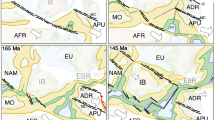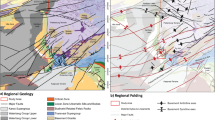Abstract
The Munébrega Plio-Quaternary half-graben is a NW-SE trending neotectonic depression located in the central sector of the intraplate Iberian Range (NE Spain). The master fault of the half-graben offsets an Upper Pleistocene pediment deposit, forming an upslope-facing scarp. A trench dug across the fault scarp exposed a 25-m wide deformation zone consisting of graben and horst fault blocks with fissures in the upper part of the scarp, and a monoclinal flexure affected by normal and reverse faults in the lower part of the scarp. We infer a minimum of three faulting events over the past 72 ka, yielding an average (maximum) recurrence interval of 24 ka. The oldest event (72–41 ka) produced an antislope scarp on the relict pediment surface, confining deposition to the downthrown block. Cross-cutting faults affecting sedimentary units deposited in the sediment trap produced by the first event provide evidence for at least two younger events (33–19? ka). The measured cumulative vertical displacement (7.4 m) yield a minimum vertical slip rate of 0.10 ± 0.01 mm/year (2σ error) for the past 72 ka. If the paleoearthquakes ruptured the whole mappable length of the fault (ca. 20 km), they probably had moment magnitudes ca. 6.9 (Stirling et al. Bull Seismol Soc Am, 2002). Such earthquakes would have been more than a magnitude unit larger than the largest ones recorded historically in the Iberian Range. These results suggest that the official seismic hazard assessments, based solely on the historic and instrumental record, may underestimate the seismic hazard in the area.








Similar content being viewed by others
References
Adrover R, Feist M, Hugueney M, Mein P, Moissenet E (1982) L’âge et la mise en relief de la formation détritique culminante de la Sierra Pelarda (prov. de Teruel, Espagne). C R Acad Sci Paris 295(II):231–236
Alfaro JA, Casas AM, Simón JL (1987) Ensayo de zonación sismotectónica en la Cordillera Ibérica, Depresión del Ebro y borde Sur Pirenaico. Estudios Geológicos 43:445–457
Anadón P, Roca E (1996) Geological setting of the Tertiary basins of Northeast Spain. In: Friend P, Dabrio CJ (eds) Tertiary basins of Spain, the stratigraphic record of crustal kinematics. Cambridge University Press, Cambridge, pp 43–48
Andeweg B (2002) Cenozoic tectonic evolution of the Iberian Peninsula. Causes and effects of changing stress fields. Dissertation, Vrije Universiteit, Amsterdam, pp 1–178
Baena J, Moreno F, Nozal F, Alfaro JA, Barranco L (1992) Mapa Neotectónico y Sismotectónico de España a escala 1:1,000,000. IGME/ENRESA. Unpublished
Blair TC, Mcpherson JG (1994) Alluvial fans and their natural distinction from rivers based on morphology, hydraulic processes, sedimentary processes, and facies assemblages. J Sediment Res A64(3):450–489
Bomer B (1960) Aspectos morfológicos de la Cuenca de Calatayud-Daroca y de sus zonas marginales. Estud Geogr 80:393–402
Burbank DW, Anderson RS (2001) Tectonic geomorphology. Blackwell, Massachussets, pp 1–274
Burillo F, Gutiérrez M, Peña JL (1985) Datación arqueológica de deformaciones tectónicas en vertientes holocenas de Sierra Palomera (Cordillera Ibérica centroriental) Actas da I Reunião do Quaternário Ibérico. Lisboa 2:355–366
Capote R, Muñoz JA, Simón JL, Liesa CL, Arlegui LE (2002) Alpine tectonics I: the Alpine system north of the Betic Cordillera. In: Gibbons W, Moreno T (eds) The Geology of Spain. The Geological Society, London, pp 367–400
Cendrero A (2003) De la comprensión de la historia de la Tierra al análisis y predicción de las interacciones entre seres humanos y medio natural. Discurso de recepción. Real Academia de Ciencias Exactas, Físicas y Naturales, Madrid, pp 1–60
Crone AH, Machette MN, Bonilla MG, Lienkaemper JJ, Pierce KL, Scott WE, Bucknam RC (1987) Surface faulting accompanying the Borah Peak earthquake and segmentation of the Lost River fault, central Idaho. Bull Seismol Soc Am 77:739–770
del Olmo P, Hernández A, Aragonés E (1983) Mapa Geológico de España, E. 1:50,000. Ateca (437). Instituto Geológico y Minero de España (I.G.M.E.) Madrid. pp 67 + map
Echeverría M (1988) Geomorfología de la rama aragonesa de la Cordillera Ibérica entre las depresiones de Calatayud y Almazán y su reborde soriano. Dissertation, Universidad de Zaragoza, pp 1–969
European Macroseismic Scale (1998) Cahiers du Centre Europeen de Geodynamique et de Seismologie 15:1–99
García-Mayordomo J, Faccioli E, Paolucci R (2004) Comparative study of the seismic hazard assessments in European national seismic codes. Bull Earthquake Eng 2(1):51–73
Giardini D, Jiménez MJ, Grünthal G (2003) European-Mediterranean Seismic Hazard Map. European Seismological Commission. http://wija.ija.csic.es/gt/earthquakes/
Gutiérrez F (1996) Gypsum karstification induced subsidence: effects on alluvial systems and derived geohazards (Calatayud Graben, Iberian Range, Spain). Geomorphology 16:277–293
Gutiérrez F (1998) Fenómenos de subsidencia por disolución de formaciones evaporíticas en las fosas neógenas de Teruel y Calatayud. Dissertation, University of Zaragoza, pp 1–569
Gutiérrez F, Gracia FJ, Gutiérrez M (1996) Consideraciones sobre el final del relleno endorreico de las fosas de Calatayud y Teruel y su paso al exorreismo. Implicaciones morfo-estratigráficas y estructurales. Cadernos do Laboratorio Xeolóxico de Laxe 21:23–43
Gutiérrez F, Gracia J, Gutiérrez M (2005) Karst, neotectonics and periglacial features in the Iberian Range. In: Desir G, Gutiérrez F, Gutiérrez M (eds) Sixth international conference on geomorphology, field trip guides 2:343–400
Gutiérrez F, Gutiérrez M, Gracia FJ, McCalpin JP, Lucha P, Guerrero J (2008) Plio-Quaternary extensional seismotectonics and drainage network development in the central sector of the Iberian Range (NE Spain). Geomorphology. doi:10.1016/j.geomorph.2007.07.020
Hemphill-Haley MA, Weldon II RJ (1999) Estimating prehistoric earthquake magnitude from point measurements of surface rupture. Bull Seismol Soc Am 89(5):1264–1279
Henares J, López-Casado C, Sanz de Galdeano C, Delgado J, Peláez JA (2003) Stress fields in the Iberian-Maghrebi region. J Seismol 7(1):65–78
Herraiz M, De Vicente G, Lindo-Ñaupari R, Giner J, Simón JL, González-Casado JM, Vadillo O, Rodríguez-Pascua MA, Cicuéndez JI, Casas A, Cabañas L, Rincón P, Cortés AL, Ramírez M, Lucini M (2000) The recent (upper Miocene to Quaternary) and present tectonic stress distributions in the Iberian Peninsula. Tectonics 19(4):762–786
Instituto Geográfico Nacional (2007) Catálogo de sismos próximos. http://www.ign.es/ign/es/IGN/SisCatalogo.jsp
Jabaloy A, Galindo-Zaldívar J, González-Lodeiro F (2002) Palaeostress evolution of the Iberian Peninsula (late Carboniferous to present-day). Tectonophysics 357(1–4):159–186
Jiménez MJ, García-Fernández M, The GSHAP Ibero-Maghreb Working Group (1999) Seismic hazard assessment in the Ibero-Maghreb region. Ann Geofis 42(6):1057–1065
Jiménez MJ, Giardini D, Grünthal G, SESAME Working Group (2001) Unified seismic hazard modelling throughout the Mediterranean Region. Boll Geofis Teorica Appl 42(1–2):3–18
Jiménez MJ, Giardini D, Grünthal G (2003) The ESC-SESAME Unified Hazard Model for the European-Mediterranean region. Centre Sismologique Euro-Méditerranéen/European-Mediterranean Seismological Centre (CSEM/EMSC) Newsletter 19:2–4
Leeder MR, Jackson JA (1993) The interaction between normal faulting and drainage in active extensional basins, with examples from the western United States and central Greece. Basin Res 10:7–18
Machette MN (1985) Calcic soils of the southwestern United States. In: Weide DL (ed) Quaternary soils and geomorphology of the american southwest. Geological Society of America, Special Paper 203, pp 1–21
Martín-Serrano A (ed) (2005) Mapa geomorfológico de España y del margen continental escala 1:1,000,000. Instituto Geológico y Minero de España, Madrid, pp 1–232 + 2 maps
Martínez-Solares JM, Mezcua J (2002) Catálogo sísmico de la Península Ibérica (880 a.C.–1900). Monografía 18, Instituto Geográfico Nacional, Madrid, pp 1–253
Masana E, Villamarín JA, Sánchez-Cabañero J, Plaza J, Santanach P (2001) Seismogenic faulting in an area of low seismic activity: paleoseismicity of the El Camp fault (Northeast Spain). Geol Mijnbouw 80(3–4):229–241
McCalpin JP (1996) Paleoseismology in extensional tectonic environments. In: McCalpin JP (ed) Paleoseismology. Academic Press, San Diego, pp 85–146
McCalpin JP (2005) Late Quaternary activity of the Pajarito fault, Rio Grande rift of northern New Mexico, USA. Tectonophysics 408:213–236
Mezcua J (1982) Catálogo general de isosistas de la Península Ibérica. Instituto Geográfico Nacional, Madrid, pp 1–59 + 261 maps
Ministerio de Fomento (2002) Real Decreto 997/2002, de 27 de septiembre, por el que se aprueba la norma de construcción sismorresistente: parte general y edificación (NCSR-02). Boletín Oficial del Estado, 11 October, pp 35898–35967
Ministerio de Fomento (2003) Norma de construcción sismorresistente: parte general y edificación (NCSR-02). Con comentarios de la Subcomisión Permanente de Normas Sismorresistentes. Centro de Publicaciones del Ministerio de Fomento, Madrid (Spain), pp 1–94
Ministerio del Interior (2004) Resolución de 17 de septiembre de 2004, de la Subsecretaría, por la que se ordena la publicación del Acuerdo del Consejo de Ministros, de 16 de julio de 2004, por el que se modifica la Directriz básica de planificación de protección civil ante el riesgo sísmico, aprobada por el Acuerdo del Consejo de Ministros, de 7 de abril de 1995. Boletín Oficial del Estado, 2 October, pp 33205–33208
Myers WB, Hamilton W (1964) Deformation accompanying the Hebgen lake earthquake of August 17, 1959. U.S. Geological Survey Professional Paper 435, pp 55–98
Olaiz A, De Vicente G, Muñoz Martín A, Vegas R (2006) Mapa de esfuerzos de Europa a partir de mecanismos focales calculados desde el tensor de momento sísmico. Geogaceta 40:55–58
Pantosti D, Schwartz DP, Valensise G (1993) Paleoseismology along the 1980 surface rupture of the Irpina fault; implications for earthquake recurrence in the southern Apennines, Italy. J Geophys Res 98:6561–6577
Perea H, Figueiredo PM, Carner J, Gambini S, Boydell K (2003) Paleoseismological data from a new trench across the El Camp Fault (Catalan Coastal Ranges, NE Iberian Peninsula). Ann Geophys 46(5):763–774
Reiter L (1990) Earthquake hazard analysis; issues and insights. Columbia University Press, New York, pp 1–254
Reiter L (1995) Paleoseismology—a user’s perspective. In: Serva L, Slemmons DB (eds) Perspectives in Paleoseismology. Association of Engineering Geologists Special Publication, vol 6, pp 3–6
Rey Pastor A, Bonelli J (1957) El sismo de Daroca-Used del 28 de Septiembre de 1953 y su relación con la línea sismotectónica del Jiloca. Instituto Geográfico Catastral, pp 1–16
Rockwell TK, Ben-Zion Y (2007) High localization of primary slip zones in large earthquakes from paleoseismic trenches: observations and implications for earthquake physics. J Geophys Res 112:B10304
Samardjieva E, Payo G, Badal J (1999) Magnitude formulae and intensity-magnitude relations for early instrumental earthquakes in the Iberian Region. Nat Hazards 19(2–3):189–204
Simón JL (1989) Late Cenozoic stress field and fracturing in the Iberian Chain and Ebro Basin (Spain). J Struct Geol 11:285–294
Sopeña A, Gutiérrez-Marco JC, Sánchez-Moya Y, Gómez JJ, Mas R, García A, Lago M (Coords.) (2004) Cordilleras Ibérica y Costero Catalana. In: Vera JA (ed) Geología de España. IGME, Madrid, pp. 467–470
Stirling M, Rhoades D, Berryman K (2002) Comparison of earthquake scaling relations derived from data of the instrumental and preinstrumental era. Bull Seismol Soc Am 92(2):812–830
Tena JM, Mandado JA (1984) Estudio geológico de la Cuenca terciaria de Calatayud-Daroca. Rev Acad Cienc Zaragoza 39:69–78
Wells DL, Coppersmith KJ (1994) New empirical relationships among magnitude, rupture length, rupture width, rupture area, and surface displacement. Bull Seismol Soc Am 84(4):974–1002
Acknowledgments
The authors are very grateful to Mr. Santiago Galve for giving permission to dig the trench in his property, and to Dr. Juan Herrero for hel** in the interpretation of the soil horizons exposed in the trench walls. Excellent and thorough reviews by Dr. Kris Vanneste and Dr. José J. Martínez-Díaz substantially improved the original version of the manuscript. FG forms part of the consolidated research group “Geomorphology and Global Change-E68” of the Aragón Government. This work has been co-financed by the Spanish Education and Science Ministry and the FEDER (project CGL2007–60766) as well as by the Aragón Government (PM008/2007).
Author information
Authors and Affiliations
Corresponding author
Rights and permissions
About this article
Cite this article
Gutiérrez, F., Masana, E., González, Á. et al. Late Quaternary paleoseismic evidence on the Munébrega half-graben fault (Iberian Range, Spain). Int J Earth Sci (Geol Rundsch) 98, 1691–1703 (2009). https://doi.org/10.1007/s00531-008-0319-y
Received:
Accepted:
Published:
Issue Date:
DOI: https://doi.org/10.1007/s00531-008-0319-y




